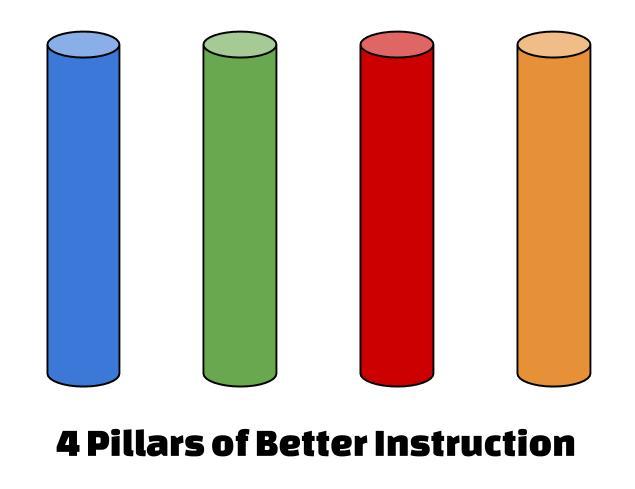To better manage an adult classroom and to improve their educational outcomes, build a foundation using 4 pillars of instruction.
Having the honor to instruct thousands and thousands of student participants has taught me more than a few things about being a better instructor.
Some of their lessons humbled me, some empowered me, some scalded me. And some simply taught me the value and importance being competent as an instructor.
Even as a professional instructor, I hope to continue to learn as much from my next 15,000+ students.
World-Class Instruction
"If you want to build a ship, don't herd people together to collect wood and don't assign them tasks and work, but rather teach them to long for the endless immensity of the sea."
~ Antoine de Saint-Exupery
To be a world-class instructor, it's important to understand that there are - at least - 4 pillars of instruction.
And to be clear, being a better instructor is not the END of the story but the BEGINNING.
- The goal of any instruction is for the student to gain competency in the given topic, not for the instructor to boast about some instructional conquest.
- In fact, the best instructors are more of a facilitator, coach, and mentor that help support the student's learning objectives.
And yep, I learned that from an instructional mentor of mine.
Enter your info and I'll send you your free report with the 4 pillars of instruction.
The 4 Pillars of Better Instruction

I. Content Knowledge
Seems silly but there are instructors that have never stepped foot in the real world of their topic but can read off of a PowerPoint slide like a pro.
Since you were drawn to an article about the 4 pillars of instruction, I assume you have been in a class like that.
Typically, the first tough question the poser gets will either throw them off their "game" or will result in them belittling the questioner.
(Read: "I have no idea what the answer is or how to answer it.")
Not having reality-based content knowledge may not be perilous in some instances.
However, in the real world of crisis leadership and other highly consequential topics, lacking real-world experience can cost someone a lot of money, an injury, or worse.
You can't fake it 'til you make it when it comes to being a subject matter expert (SME).
"Experience is not always the kindest of teachers, but it is surely the best."
~ Spanish Proverb
Now, this is not to be confused with the instructor who is early in the development of their knowledge, skills, and abilities.
We were ALL new at some point. Being an apprentice to a competent instructional mentor for a while can go a long way to building or strengthening your 4 pillars of better instruction.
Remember, nobody knows everything.
Although there may be that guy in the back of the room that sure does want to convince you that he does.
II. Classroom Management
Students that are hard chargers are the ones that are wanting, needing and requiring that your instruction makes them better.
And why wouldn't they? They've traded their time and money for your time and instruction.
If your instruction doesn't enable them to be better by the time they leave they'll eat you alive and then spit you out for having wasted their time.
And deservedly so.
- While I'm not suggesting that you bite back ... it is important to know what motivates each participant to be there, to listen and to engage.
- And the expectation of being better off when they leave your class is one of them.
When I first started teaching professionally, I learned the old adage of "finish early and be funny" and there's some truth to that.
Time Management
Nobody likes to be late, regardless of the excuse.
When you're standing between them and their next meal, their certificate or their precious time off, be on time.
Without fail.
Humor
Humor requires a delicate balance. Within reason, be self-effacing, insert a humorous story to make an instructional point and even toss in a little sarcasm.
There's also a fine line between the blue humor (sometimes appropriate for crusty responders) and the inappropriate humor that can offend even one person.
Jokes dealing with race or sex usually lead the list of those references that are off-limits.
Disruptive Students
If you don't get to pick your students (most of us don't) then you also have the other end of the spectrum.
Students that want to hijack your class, pontificate about their way, or run their extra job during the class are detrimental to your other students.
Like dogs, kids and politicians, this type of student will continue to do what they are reinforced for doing.
And allowing any aberrant behavior to continue will only cause it to increase. All while your reputation as an instructor goes in the toilet.
In private preferably but in public if you must, get these fringe elements under control before they start controlling the flow of you and your course.
Effective classroom management is like racing to the finish line with one foot on the gas and one on the brake. ~Mike McKenna
III. Instructor Ability
Adults v. Children
Teaching adults is not the same as teaching children.
- Teaching most children is like pulling a 3-wheeled wagon across the sand.
Scholars of learning theory call this pedagogy - or dependent learning.
- Teaching most adults however is like racing across the icy tundra on a mountain bike at night.
This is called andragogy - or autonomous learning.
- Teaching hard-charging responders is like driving a convertible Ferrari through the Serengeti, backward, during dinner time.
Some of these folks eat their young so being a weak instructor can prove to be nearly fatal.
Fear not though, time-in-service as an instructor builds the skills needed to deal effectively with these adult learners.
Read more about adult and child learning philosophy, here.
"The mediocre teacher tells. The good teacher explains. The superior teacher demonstrates. The great teacher inspires."
~ William A. Ward
Work the Room
One such skill is knowing when to apply the gas or the brake. By carefully and systematically scanning the class you can gauge the classroom's level of engagement and comprehension.
Be aware of signs of stress, excess animation, distraction/disinterest, a state of confusion or snoring (a great indicator of lack of engagement by the way!). A skilled instructor will ramp their rhetoric, their animation/stimulus or their cadence up or down to meet the vibe in the class.
Just like a gas pedal and a brake pedal.
To do this while the class is ongoing takes some practice but real-time adjustments to the flow of the course make for happy students so the effort is worth it.
IV. Humility
Just because you are the instructor does not mean you are the smartest person in the room.
Allow me to emphasize this point: You are not the smartest person in the room.
20+ years of instructing experience, being classified as an expert witness, and earning a specialist designation at a handful of skills have reinforced a valuable lesson. Believe me when I tell you that there will ALWAYS be someone smarter in the room about something.
I've had the honor to work with some world-class instructors ... the kind that you can't wait until they speak again because you know it will be golden. Regardless of their topic, the ONE (1) common theme is their humility.
Kids and the uninitiated may be impressed with the chest thumping and sparkling resume. However, most adult learners will simmer quietly, dismissively and remember more about your arrogance than anything you tried to teach them.
Check your ego at the door (or don't invest in one to begin with!) because a good instructor also learns from the student and then uses what they learn to use to help future students.
"Humility is not thinking less of yourself, but thinking of yourself less."
~ C.S. Lewis
Record-Keeping
Another mentor of mine suggested years ago that I keep a record of my classes both as a student and as an instructor to verify my activity by date, topic, number of students, hours, etc.
Fast forward to today I can honestly say that the effort has been well worth it.
[Subscribers to my instructor email list receive an instruction tracking template that I use. Sign up below.]
For 20+ years, I've captured the exact number of classes, the number of students and number of hours. Those stats also tell another tale ... the number of repetitions that have allowed me to make mistakes, make strides and make adjustments.
And for that, I am eternally grateful for the mentors, students, and clients that have trusted me with helping them be better.
These pillars of instruction have helped me build a reputable body of work.
How about you?

